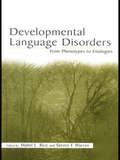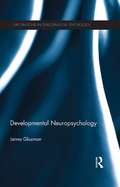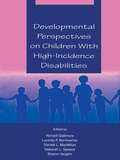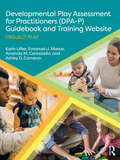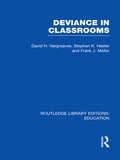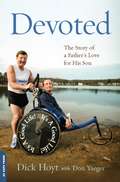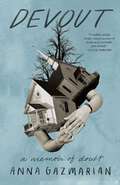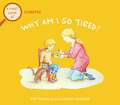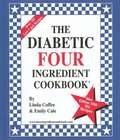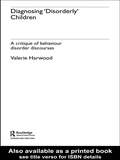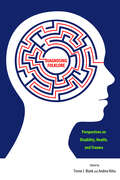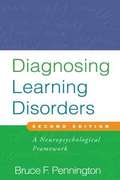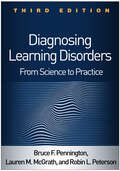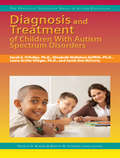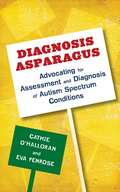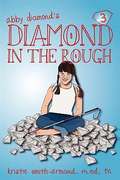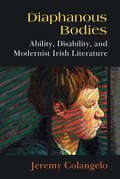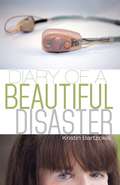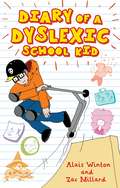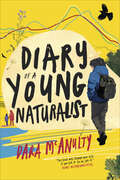- Table View
- List View
Developmental Language Disorders: From Phenotypes to Etiologies
by Mabel L. Rice Steven F. WarrenDevelopmental Language Disorders: From Phenotypes to Etiologies is based on the recent conference of the same name sponsored by the Merrill Advanced Studies Center of the University of Kansas. In the past 10 years, considerable advances have taken place in our understanding of genetic and environmental influences on language disorders in children. Significant research in behavioral phenotypes, associated neurocortical processes, and the genetics of language disorders has laid the foundation for further breakthroughs in understanding the reasons for overlapping etiologies, as well as the unique aspects of some phenotypes. Too often the findings are disseminated in a fragmented way because of the discrete diagnostic categories of affectedness. This volume attempts to assimilate and integrate the findings of the transdisciplinary research toward a more coherent picture of behavioral descriptions, brain imaging studies, genetics, and intervention technologies in language impairment. The contributing authors are all scholars with active programs of research funded by the National Institutes of Health involving diverse clinical groups of children with language impairments.
Developmental Neuropsychology (Explorations in Developmental Psychology)
by Janna GlozmanDevelopmental Neuropsychology draws upon the research of Alexander Luria and Lev Vygotsky to present a comprehensive study of developmental neuropsychology from a Russian, and Western perspective. Janna Glozman offers a fresh and accessible analysis of Luria and Vygotsky’s collaboration, which greatly influenced the field of neuropsychology as we know it today. The text provides an examination of theoretical and methodological foundations of developmental neuropsychology, which Glozman describes and systemizes, before providing methods of assessment and neuropsychological aspects of specific situations. In her work Glozman considers: abnormal social mechanisms methods of assessment and remediation historical developments specific disabilities including dyslexia, ADHD and autism Glozman’s comparative text makes Russian developmental psychology practically accessible to a western audience. It is valuable reading for researchers in developmental and clinical psychology, as well as professionals in special education, speech therapy and social work.
Developmental Perspectives on Children With High-incidence Disabilities (The LEA Series on Special Education and Disability)
by Ronald Gallimore Lucinda P. Bernheimer Donald L. MacMillan Deborah L. Speece Sharon VaughnThis volume has two purposes. The first is to summarize, substantiate, and extend current knowledge on the development of children with high incidence disabilities--most notably, learning disabilities, behavioral disorders, and mild mental retardation. The second is to honor the career of Professor Barbara K. Keogh and her contributions to the developmental study of children with high incidence disabilities. Internationally recognized for her accomplishments, Keogh is esteemed for her originality and clarity of thought. For nearly forty years, she has set an extraordinary model of analytic rigor combined with a kind and generous manner that inspires, supports, and sets an exacting standard of scholarship. The contributing authors to this volume represent only a fraction of the students and scholars touched by her distinguished career. In conceiving this volume, the editors sought to represent the topics, problems, and issues to which Keogh has devoted herself. They invited chapters that summarize what is known about the high incidence handicapping conditions that her research has mainly addressed and sought to reflect the probing, questioning style that she brings to her own work. Researchers, policymakers, and graduate students in special education and associated disciplines who seek to stay current will find this volume crucial reading.
Developmental Play Assessment for Practitioners (DPA-P) Guidebook and Training Website: Project Play
by Karin Lifter Emanuel J. Mason Amanda M. Cannarella Ashley D. CameronDevelopmental Play Assessment for Practitioners (DPA-P) Guidebook and Training Website: Project Play offers a comprehensive assessment of naturally occurring play activities for evaluating young children’s developmental progress accurately, so that useful interventions can take place as early as possible. It can be used by practitioners in a wide range of educational and therapeutic settings and is designed to support developmental progress through planning interventions in play, and using what we know about a child’s progress in play to plan play-based interventions in cognition, language, motor, social-emotional, and self-help skills. The guidebook and training website provide a comprehensive introduction to how to successfully use the assessment with infants, toddlers, and young children with disabilities or at risk for disabilities. The comprehensive guidebook offers an overview of the DPA-P and Project Play, defines play, discusses the background literature on play, and explains why this assessment is needed. Clear guidance helps practitioners and family members understand play, how to evaluate play, and how to use play for different purposes. The guidebook offers: an introduction to the comprehensive training website and how to use it understanding of the categories of play assessed and their definitions guidance on how to administer the assessment and prepare a summary evaluation of a child’s performance clear instructions for the coding sheets and scoring guidelines for constructing sets of toys guidance on taking the results of the DPA-P evaluation of a child’s progress in play to develop a plan of activities for intervention explanation of how you evaluate activities at the absence, basic, emergence, and mastery levels for developing a plan suggestions for assembling sets of toys for intervention, based on toys available in children’s homes and early childhood settings procedures for facilitating or teaching play activities to children who are developing more slowly than their peers technical aspects of the assessment To make the DPA-P as flexible as possible for all practitioners, it also offers guidance on adaptations for administering the test, in the coding sheets, with toys to enhance cultural appropriateness for gathering the observations, and for supporting interventions in play. The Developmental Play Assessment for Practitioners (DPA-P) can be used in natural settings and takes 30 minutes to complete. It is a valuable tool for all those who serve, or are training to serve, young children in early childhood settings, schools, service agencies, colleges, and universities. It will be of great benefit for early intervention personnel, speech-language pathologists, physical therapists, occupational therapists, and psychologists.
Deviance in Classrooms (Routledge Library Editions: Education)
by Stephen Hester David H Hargreaves Frank J MellorWhen originally published this book reported the first major application of ‘labelling theory’ to deviance in classrooms. The authors explore the nature of classroom rules, show how they constitute a pervasive feature of the classroom, and examine the ways in which teachers use these rules as grounds for imputing ‘deviance’ to pupils. A theory of social typing is developed to show how teachers come to define certain pupils as deviant persons such as ‘troublemakers’ and several case-studies are used to document this analysis. Finally, the teachers’ reactions to disruptive classroom conduct are examined as complex strategic attempts at social control in the classroom. The book has a double focus on deviance theory and the process of teaching.
Devoted: The Story of a Father's Love for His Son
by Don Yaeger Don HoytThe remarkable story of a father's devotion to his wheelchair-bound son and how their bond inspired millions of people worldwide. Born a spastic quadraplegic, Rick Hoyt was written off by numerous doctors. They advised his parents, Dick and Judy, to put their firstborn son in an institution. But Rick's parents refused. Determined to give their son every opportunity that "normal" kids had, they made sure to include Rick in everything they did, especially with their other two sons, Rob and Russ. But home was one thing, the world at large, another. Repeatedly rebuffed by school administrators who resisted their attempts to enroll Rick in school, Rick's mother worked tirelessly to help pass a landmark bill, Chapter 766, the first special-education reform law in the country. As a result, Rick and other physically disabled kids were able to attend public school in Massachusetts. But how would Rick communicate when he couldn't talk? To overcome this daunting obstacle, Dick and Judy worked with Dr. William Crochetiere, then chairman of the engineering department at Tufts University, and several enterprising graduate students, including Rick Foulds, to create the Tufts Interactive Communication device (TCI). In the Hoyt household, it became known as the "Hope machine," as it enabled Rick to create sentences by pressing his head against a metal bar. For the first time ever, Rick was able to communicate. Then one day Rick asked his dad to enter a charity race, but there was a twist. Rick wanted to run too. Dick had never run a race before, but more challenging still, he would have to push his son's wheelchair at the same time. But once again, the Hoyts were determined to overcome whatever obstacle was put in their way. Now, over one thousand races later, including numerous marathons and triathlons, Dick Hoyt continues to push Rick's wheelchair. Affectionately known worldwide as Team Hoyt, they are as devoted as ever, continuing to inspire millions and embodying their trademark motto of "Yes, you can. "
Devout: A Memoir of Doubt
by Anna Gazmarian&“This moving memoir is always attuned to the possibilities of community and spiritual sustenance, even as it refuses to efface the struggles at its core—believing that this struggle, too, can be a thing of beauty.&” —Leslie Jamison, author of The RecoveringIn this revelatory memoir, Anna Gazmarian tells the story of how her evangelical upbringing in North Carolina failed to help her understand the mental health diagnosis she received, and the work she had to do to find proper medical treatment while also maintaining her faith. When Anna is diagnosed with bipolar disorder in 2011, she&’s faced with a conundrum: while the diagnosis provides clarity about her manic and depressive episodes, she must confront the stigma that her evangelical community attaches to her condition. Over the course of ten years, we follow Anna on her journey to reframe her understanding of mental health to expand the limits of what her religious practice can offer. In Devout: A Memoir of Doubt, Anna shows that the pursuing our emotional health and our spiritual well-being is one single mission and, in both cases, an act of faith.
Dexterity
by Douglas BauerAs a teenager in a small town in upstate New York, Ramona is infatuated with handsome, domineering Ed King, but after their marriage she quickly loses her illusions. When her hand is severed in an accident she feels she can no longer care for their infant son. She flees from Ed and the town, leaving her son behind. In alternating chapters the novel follows Ramona's flight and reveals the effect of her disappearance on Ed.
Diabetes and You: Taking Charge of Your Health (Cornerstones4Care)
by Novo NordiskProvides basic and easy to understand information on what diabetes is, what impact it has on your body and how the various treatments work. Provides a check list and a sample care plan.
Diabetes, Vision Impairment, and Blindness
by Allene R. Van SonVision impairment is a common complication of diabetes mellitus, which is itself the leading cause of new cases of blindness among adults in the United States. Three percent of the country's 10 million diabetics have experienced severe vision loss as a result of the disease. This means that diabetics frequently have to face additional problems of impending loss of vision and blindness. The purpose of this pamphlet is to explain the relationship between visual impairment and diabetes and to identify recent advances in treatment and rehabilitation to help diabetics and their families deal with the problems of vision loss.
Diabetes: Why am I so tired? (A First Look At #17)
by Pat ThomasA First Look at Diabetes is a gentle introduction to what diabetes is, what the symptoms are and what can be done to control it.The superb A First Look At series consists of a number of reassuring picture books that give advice and promote interaction between children, parents, and teachers on a wide variety of personal, social and emotional issues.Notes for parents and teachers at the back of the book provide valuable advice for how to share this book with your child or class.Suitable for Key Stage 1 (ages 5-7), occasional prompts throughout the text give a chance to discuss the issue being raised.Written by trained psychotherapist, journalist and parent, and illustrated by an experienced children's book artist, this is a part of an acclaimed and successful, long-running series of picture-book non-fiction books for Early Years. Books in the series give advice and promote interaction between children, parents and teachers on a wide variety of personal, social and emotional issues. They are excellent tools for teachers to use during classroom discussions.
The Diabetic Four Ingredient Cookbook
by Linda Coffee Emily CaleFrom the back cover: Diabetics and Health-minded People-Take Note! If you are trying to eat a healthier diet because of diabetes or just because you know it is the best decision for you, but you are struggling with limited time or energy . . . this cookbook is a lifesaver! This new large print edition, The Diabetic Four Ingredient Cookbook, is a practical kitchen tool for busy cooks who must or want to eat healthy. Over 150 new recipes have been added. Each simple recipe provides the nutritional analysis, along with the exchanges. There are also more than 180 recipes that are low in carbohydrates and easily located by the Low Carb next to the recipe name. This book is full of delicious, easy recipes!
Diagnosing 'Disorderly' Children: A critique of behaviour disorder discourses
by Valerie HarwoodBased on the author's in-depth research with children diagnosed with behavioural difficulties, this book provides a thorough critique of today's practices, examining: the traditional analyses of behavioural disorders and the making of disorderly children the influence of the 'expert knowledge' on behavioural disorders and its influence on schools, communities and new generations of teachers the effect of discourses of mental disorder on children and young people the increasing medicalisation of young children with drugs such as Ritalin. This book offers an innovative and accessible analysis of a critical issue facing schools and society today, using Foucaultian notions to pose critical questions of the practices that make children disorderly. Rich in case studies and interviews with children and young people, it will make fascinating reading for students, academics and researchers working in the field of education, inclusion, educational psychology, sociology and youth studies.
Diagnosing Folklore: Perspectives on Disability, Health, and Trauma
by Trevor J. Blank Andrea KittaDiagnosing Folklore provides an inclusive forum for an expansive conversation on the sensitive, raw, and powerful processes that shape and imbue meaning in the lives of individuals and communities beleaguered by medical stigmatization, conflicting public perceptions, and contextual constraints. This volume aims to showcase current ideas and debates, as well as promote the larger study of disability, health, and trauma within folkloristics, helping bridge the gaps between the folklore discipline and disability studies. This book consists of three sections, each dedicated to key issues in disability, health, and trauma. It explores the confluence of disability, ethnography, and the stigmatized vernacular through communicative competence, esoteric and exoteric groups in the Special Olympics, and the role of family in stigmatized communities. Then, it considers knowledge, belief, and treatment in regional and ethnic communities with case studies from the Latino/a community in Los Angeles, Javanese Indonesia, and Middle America. Lastly, the volume looks to the performance of mental illness, stigma, and trauma through contemporary legends about mental illness, vlogs on bipolar disorder, medical fetishism, and veterans' stories.
Diagnosing Learning Disorders, Second Edition
by Bruce PenningtonFrom a trusted expert in the field, this authoritative work provides an accessible overview of what learning disorders are, how they develop, and how to diagnose and treat them effectively. The author presents the most current neuroscientific knowledge on a range of conditions, including dyslexia, autism spectrum disorders, attention-deficit/hyperactivity disorder, and others. Practitioners gain vital insights and tools for making sense of children's impairments and strengths, collecting and interpreting diagnostic data from a variety of sources, and linking diagnosis to evidence-based interventions. The second edition has been substantially revised and expanded to reflect significant clinical and research advances. New to This Edition Covers additional disorders intellectual disability, mathematics disorder, and developmental coordination disorder, plus a chapter on less well-validated disorders. New case illustrations and a focus on empirically based practice. Now grounded in a multiple cognitive-deficit model of learning disorders, replacing the prior edition's modular, single-deficit model. An illuminating chapter on controversial therapies separates myths from facts.
Diagnosing Learning Disorders, Third Edition: From Science to Practice
by Bruce F. Pennington Lauren M. McGrath Robin L. PetersonA definitive reference--now extensively revised with 70% new material--this book presents cutting-edge knowledge on how learning disorders develop and how to diagnose and treat them effectively. In additional to dyslexia and mathematics disabilities, the book covers speech and language disorders, attention-deficit/hyperactivity disorder, autism spectrum disorder, and intellectual disability. Accessibly written, it is grounded in genetics, neuroscience, and developmental neuropsychology. Clinicians and educators are guided to make sense of children's impairments and strengths and make sound diagnostic decisions. Best practices in intervention are reviewed. User-friendly features include case examples and summary tables in each disorder-specific chapter. New to This Edition *Revised throughout to reflect major theoretical, empirical, and technological advances. *Chapters on etiology, brain development, and comorbidity. *Chapters on DSM-5 diagnosis of specific learning disorder, evidence-based assessment, and achievement gaps.
Diagnosis and treatment of blind and visually impaired
by Dolly SinghThis publication provides readers with an understanding of visual impairment and blindness, particularly the cortical visual impairment. An overview of eye diseases, low vision, vision loss, and blindness is given. Uses of assistive technology, remote infrared audible signage and GPS for visually impaired are described.
Diagnosis and Treatment of Children With Autism Spectrum Disorders
by Sarah E. O'Kelley Elizabeth Mcmahon Griffith Laura Grofer Klinger Sarah Ann MccurryThis new series offers timesaving books on critical topics for educating students with autism spectrum disorders. The four books in this series are filled with practical information and advice, thus making them an ideal resource for classroom teachers, preservice teachers, and graduate students. This book provides an overview of the screening procedures and diagnostic criteria for students with autism spectrum disorders. The most current, research-based treatment therapies for students with this diagnosis also are presented.
Diagnosis Asparagus: Advocating for Assessment and Diagnosis of Autism Spectrum Conditions
by Eva Penrose Catherine O'HalloranA highly readable, insightful and sometimes humorous account of autism assessment, diagnosis and life with a 'label'. Eva was diagnosed with Asperger Syndrome (ASD) at age 11 and is now a fun-loving, sociable 16-year-old. This book, co-written with her mother, a speech and language therapist, discusses their reasons for seeking a diagnosis, the process of being assessed, their reactions to the news and the impact it has had on Eva's life. It also considers how diagnosis has helped them find strategies to lessen the challenges of living with an ASD. Concluding that it doesn't really matter whether the name for the set of traits that characterise autism changes or what it changes to, this life-affirming book shows diagnosis to be a positive and empowering experience. It will be helpful to any family embarking on the assessment process as well as professionals looking for insight into a family's diagnosis journey.
A Diamond in the Darkness
by Veni RajThen one day Bahá'í teachers came to his village with a Great Message and things began to happen not only for the village but for Liaz as well. This true and inspiring story, generously illustrated by Tushar Kanti-Paul, will be enjoyed by children, youth and adults, as well.
Diamond in the Rough: More Fun Adventures with Abby Diamond
by Kristie Smith-Armand<P>Abby Diamond, Girl Detective, returns once again with her lovable and popular friends. Abby does not allow her visual impairment to stand in the way of her solving mysteries that surround her and Neils, Alison, Andrea, Jaxson and Glen. <P>In the third novel of the series, "Diamond in the Rough", Abby and her friends meet up with children and adults who are not what they seem to be. Are the new friends in this series really ghosts or the figment of Abby's imagination? Children and adults will laugh when Abby and her gang learn about a mysterious boy named Cliff who takes them on a whirlwind of bicycle hills and mysteries. Abby grows up in the series and runs a detective agency with her best friends Jaxson and Neils. Did this really happen or is it simply Abby's imagination once again? <P>Join Abby and her friends through this fast-paced novel that will leave children begging for more Adventures of Abby Diamond.
Diaphanous Bodies: Ability, Disability, and Modernist Irish Literature (Corporealities: Discourses Of Disability)
by Jeremy ColangeloDiaphanous Bodies: Ability, Disability, and Modernist Irish Literature examines ability, as a category of embodiment and embodied experience, and in the process opens up a new area of inquiry in the growing field of literary disability studies. It argues that the construction of ability arises through a process of exclusion and forgetting, in which the depiction of sensory information and epistemological judgment subtly (or sometimes un-subtly) elide the fact of embodied subjectivity. The result is what Colangelo calls “the myth of the diaphanous abled body,” a fiction that holds that an abled body is one which does not participate in or situate experience. The diaphanous abled body underwrites the myth that abled and disabled constitute two distinct categories of being rather than points on a constantly shifting continuum. In any system of marginalization, the dominant identity always sets itself up as epistemologically and experientially superior to whichever group it separates itself from. Indeed, the norm is always most powerful when it is understood as an empty category or a view from nowhere. Diaphanous Bodies explores the phantom body that underwrites the artificial dichotomy between abled and disabled, upon which the representation of embodied experience depends.
Diary of a Beautiful Disaster
by Kristin BartzokisFeatures 8-page photo insert!“I highly recommend ‘Diary of a Beautiful Disaster’ as a journey through what it means to be a completely, and unflinchingly, beautiful human being.” - David Roche, humorist and author, “The Church of 80% Sincerity”She had just scored a perfect ten on her floor exercise routine, but Kristin Bartzokis stood stoically before the screaming crowd.For Kristin, this moment of perfection was something she always knew she could achieve. She’d been raised to live without limitations, and she’d adopted a determination to stay strong and unemotional, no matter what.Born with Treacher Collins Syndrome, a facial abnormality, Kristin learned at an early age the importance of strength–strength when confronted with multiple surgeries, strength when confronted with stares and questions, and strength when confronted with the constant knowledge that you will never look, or be, like everyone else.Kristin Bartzokis’ life story is one of achievement and inspiration, an example of an unbreakable spirit and unwavering fortitude. No matter what life has thrown at Kristin, she has turned challenges into triumphs and used obstacles as stepping stones.Diary of a Beautiful Disaster empowers readers to embrace their own uniqueness and boldly go forth into the world being exactly who they are. Kristin reminds us that although life can be complicated and messy, it is always, above all, beautiful.“ ‘Diary of a Beautiful Disaster’ is a moving memoir, but more than that it is an honest, sincere front-row peek into one woman’s ability to persevere, overcome, and find true acceptance.” – Erica Mossholder, executive director, Children’s Craniofacial Association
Diary of a Dyslexic School Kid
by Alais Winton Zac MillardExperience day-to-day life for a dyslexic kid, including school life, bullying and coping with tests and homework, in this frank and funny diary. Co-authored with a teenage boy with dyslexia and illustrated with cartoons, this is a positive yet honest look at the difficulties of being dyslexic. Using a simple and relatable approach, the authors display the ups and downs of school - and home - life with a reading difficulty, focussing on the sometimes overwhelming experience of being at a bigger school and studying loads of new subjects. Providing tips for what really helps and works based on real-life experience, this fun, accessible book shows teens and tweens with dyslexia that they are far from alone in their experiences.
Diary of a Young Naturalist
by Dara McAnultyA BuzzFeed "Best Book of June 2021"From sixteen-year-old Dara McAnulty, a globally renowned figure in the youth climate activist movement, comes a memoir about loving the natural world and fighting to save it.Diary of a Young Naturalist chronicles the turning of a year in Dara&’s Northern Ireland home patch. Beginning in spring?when &“the sparrows dig the moss from the guttering and the air is as puffed out as the robin&’s chest?these diary entries about his connection to wildlife and the way he sees the world are vivid, evocative, and moving.As well as Dara&’s intense connection to the natural world, Diary of a Young Naturalist captures his perspective as a teenager juggling exams, friendships, and a life of campaigning. We see his close-knit family, the disruptions of moving and changing schools, and the complexities of living with autism. &“In writing this book,&” writes Dara, &“I have experienced challenges but also felt incredible joy, wonder, curiosity and excitement. In sharing this journey my hope is that people of all generations will not only understand autism a little more but also appreciate a child&’s eye view on our delicate and changing biosphere.&”Winner of the Wainwright Prize for UK nature writing and already sold into more than a dozen territories, Diary of a Young Naturalist is a triumphant debut from an important new voice.
